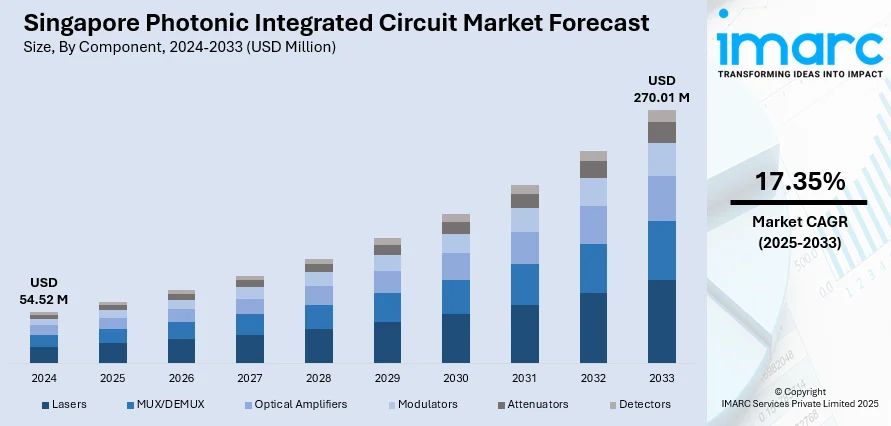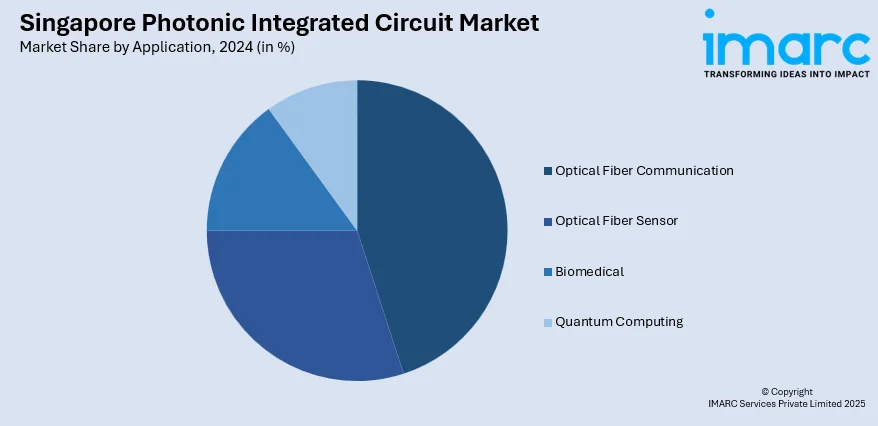
Singapore Photonic Integrated Circuit Market Size, Share, Trends and Forecast by Component, Raw Material, Integration, Application, and Region, 2025-2033
Singapore Photonic Integrated Circuit Market Overview:
The Singapore photonic integrated circuit market size reached USD 54.52 Million in 2024. Looking forward, IMARC Group expects the market to reach USD 270.01 Million by 2033, exhibiting a growth rate (CAGR) of 17.35% during 2025-2033. The market is propelled by government initiatives supporting high-tech innovation, a robust semiconductor manufacturing ecosystem, and rising demand in data communications. The city-state’s strategic location as a technology hub attracts multinational PIC developers. Collaborative research between industry and academia also fuels Singapore photonic integrated circuit market share.
|
Report Attribute
|
Key Statistics
|
|---|---|
|
Base Year
|
2024
|
|
Forecast Years
|
2025-2033
|
|
Historical Years
|
2019-2024
|
| Market Size in 2024 | USD 54.52 Million |
| Market Forecast in 2033 | USD 270.01 Million |
| Market Growth Rate 2025-2033 | 17.35% |
Singapore Photonic Integrated Circuit Market Trends:
Government-Driven Innovation and Funding
Singapore’s government plays a critical role in advancing the photonic integrated circuit market through funding programs and innovation hubs. Agencies such as the Economic Development Board (EDB) and A*STAR provide grants and infrastructure support to accelerate PIC R&D and commercialization. This proactive approach encourages startups and established firms to develop cutting-edge photonics technologies tailored to regional and global demands. Consequently, this strategic support fosters technology adoption and boosts the Singapore photonic integrated circuit market growth by enhancing the ecosystem for advanced photonics manufacturing. For instance, in July 2024, Wave Photonics, in collaboration with SENKO Advanced Components and Alter Technology, launched QPICPAC, a turnkey chip packaging solution for Quantum Photonic Integrated Circuits (QPICs). QPICPAC offers design templates and components to simplify prototyping, reduce costs, and accelerate R&D for quantum tech companies. The solution supports a full UK-based supply chain, enabling rapid, scalable, and reliable packaging from design to production. It aims to standardize and streamline QPIC development for faster innovation in quantum photonics.

To get more information on this market, Request Sample
Growing Demand for Data Communication and 5G Infrastructure
Singapore’s status as a financial and technological hub generates substantial demand for high-speed data communication and robust 5G networks. Photonic integrated circuits are integral to enhancing network capacity and reducing energy consumption in telecom equipment. The rollout of 5G and anticipated 6G technologies boosts investments in PIC-enabled solutions. Additionally, data center expansion to support cloud services further stimulates PIC adoption. These factors collectively underpin the Singapore photonic integrated circuit market growth by creating sustained demand for photonics technology. For instance, in April 2025, Aixtron SE supplied Nokia with its G10-AsP MOCVD system to produce 6-inch indium phosphide (InP) wafers for advanced photonic integrated circuits (PICs), following Nokia’s $2.3 Billion acquisition of Infinera. The G10-AsP offers up to 4x better on-wafer uniformity and efficient automated wafer handling. With in-situ cleaning and precise temperature control, it enhances manufacturing efficiency and consistency. This investment strengthens Nokia’s capabilities in next-gen optical technologies and supports growing demand for high-performance PICs in telecommunications and data center applications.
Singapore Photonic Integrated Circuit Market Segmentation:
IMARC Group provides an analysis of the key trends in each segment of the market, along with forecasts at the country and regional levels for 2025-2033. Our report has categorized the market based on component, raw material, integration, and application.
Component Insights:
- Lasers
- MUX/DEMUX
- Optical Amplifiers
- Modulators
- Attenuators
- Detectors
The report has provided a detailed breakup and analysis of the market based on the component. This includes lasers, MUX/DEMUX, optical amplifiers, modulators, attenuators, and detectors.
Raw Material Insights:
- Indium Phosphide (InP)
- Gallium Arsenide (GaAs)
- Lithium Niobate (LiNbO3)
- Silicon
- Silica-on-Silicon
A detailed breakup and analysis of the market based on the raw material have also been provided in the report. This includes indium phosphide (InP), gallium arsenide (GaAs), lithium niobate (LiNbO3), silicon, and silica-on-silicon.
Integration Insights:
- Monolithic Integration
- Hybrid Integration
- Module Integration
The report has provided a detailed breakup and analysis of the market based on the integration. This includes monolithic integration, hybrid integration, and module integration.
Application Insights:

- Optical Fiber Communication
- Optical Fiber Sensor
- Biomedical
- Quantum Computing
A detailed breakup and analysis of the market based on the application have also been provided in the report. This includes optical fiber communication, optical fiber sensor, biomedical, and quantum computing.
Regional Insights:
- North-East
- Central
- West
- East
- North
The report has also provided a comprehensive analysis of all the major regional markets, which include North-East, Central, West, East, and North.
Competitive Landscape:
The market research report has also provided a comprehensive analysis of the competitive landscape. Competitive analysis such as market structure, key player positioning, top winning strategies, competitive dashboard, and company evaluation quadrant has been covered in the report. Also, detailed profiles of all major companies have been provided.
Singapore Photonic Integrated Circuit Market News:
- In April 2025, Coherent Corp. launched its 2x400G-FR4 Lite silicon photonics transceiver, designed for AI-driven data centers and Ethernet networks. The module offers 500-meter reach, reduced power consumption, and improved fiber efficiency over DR8 variants. Built with a silicon photonics PIC, it integrates lasers, photodetectors, and passive components, eliminating thermoelectric coolers. Targeted for high-volume deployment, the transceiver supports growing AI/ML workloads with energy-efficient optical interconnects.
- In March 2025, PhotonDelta and Silicon Catalyst formed a strategic partnership to accelerate early-stage photonics startups by combining their global ecosystems. Backed by $1.5 Billion, PhotonDelta offers a comprehensive photonic chip value chain, while Silicon Catalyst brings a network of 500+ semiconductor partners. The collaboration aims to boost commercialization, innovation, and global scaling of photonics, addressing energy efficiency and enabling breakthroughs in quantum computing, healthcare, and more through photonic integrated circuits (PICs).
Singapore Photonic Integrated Circuit Market Report Coverage:
| Report Features | Details |
|---|---|
| Base Year of the Analysis | 2024 |
| Historical Period | 2019-2024 |
| Forecast Period | 2025-2033 |
| Units | Million USD |
| Scope of the Report |
Exploration of Historical Trends and Market Outlook, Industry Catalysts and Challenges, Segment-Wise Historical and Future Market Assessment:
|
| Components Covered | Lasers, MUX/DEMUX, Optical Amplifiers, Modulators, Attenuators, Detectors |
| Raw Materials Covered | Indium Phosphide (InP), Gallium Arsenide (GaAs), Lithium Niobate (LiNbO3), Silicon, Silica-on-Silicon |
| Integrations Covered | Monolithic Integration, Hybrid Integration, Module Integration |
| Applications Covered | Optical Fiber Communication, Optical Fiber Sensor, Biomedical, Quantum Computing |
| Regions Covered | North-East, Central, West, East, North |
| Customization Scope | 10% Free Customization |
| Post-Sale Analyst Support | 10-12 Weeks |
| Delivery Format | PDF and Excel through Email (We can also provide the editable version of the report in PPT/Word format on special request) |
Key Questions Answered in This Report:
- How has the Singapore photonic integrated circuit market performed so far and how will it perform in the coming years?
- What is the breakup of the Singapore photonic integrated circuit market on the basis of component?
- What is the breakup of the Singapore photonic integrated circuit market on the basis of raw material?
- What is the breakup of the Singapore photonic integrated circuit market on the basis of integration?
- What is the breakup of the Singapore photonic integrated circuit market on the basis of application?
- What is the breakup of the Singapore photonic integrated circuit market on the basis of region?
- What are the various stages in the value chain of the Singapore photonic integrated circuit market?
- What are the key driving factors and challenges in the Singapore photonic integrated circuit market?
- What is the structure of the Singapore photonic integrated circuit market and who are the key players?
- What is the degree of competition in the Singapore photonic integrated circuit market?
Key Benefits for Stakeholders:
- IMARC’s industry report offers a comprehensive quantitative analysis of various market segments, historical and current market trends, market forecasts, and dynamics of the Singapore photonic integrated circuit market from 2019-2033.
- The research report provides the latest information on the market drivers, challenges, and opportunities in the Singapore photonic integrated circuit market.
- Porter's five forces analysis assist stakeholders in assessing the impact of new entrants, competitive rivalry, supplier power, buyer power, and the threat of substitution. It helps stakeholders to analyze the level of competition within the Singapore photonic integrated circuit industry and its attractiveness.
- Competitive landscape allows stakeholders to understand their competitive environment and provides an insight into the current positions of key players in the market.
Need more help?
- Speak to our experienced analysts for insights on the current market scenarios.
- Include additional segments and countries to customize the report as per your requirement.
- Gain an unparalleled competitive advantage in your domain by understanding how to utilize the report and positively impacting your operations and revenue.
- For further assistance, please connect with our analysts.
 Request Customization
Request Customization
 Speak to an Analyst
Speak to an Analyst
 Request Brochure
Request Brochure
 Inquire Before Buying
Inquire Before Buying




.webp)




.webp)












